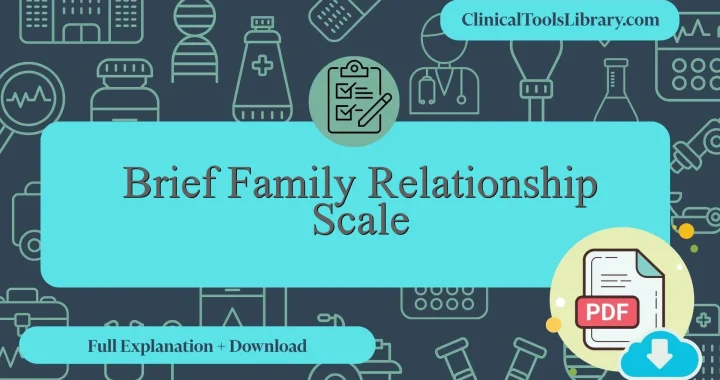In this article, we explain everything you need to know about the Brief Family Relationship Scale. We will cover the aspects it evaluates, the target population, a detailed step-by-step explanation, and how to interpret its results. Additionally, we will dive into the scientific evidence supporting this tool (diagnostic sensitivity and specificity) in clinical assessment. You will also find official and unofficial sources available for download in PDF format.
What does the Brief Family Relationship Scale assess?
The Brief Family Relationship Scale assesses the quality and dynamics of familial interactions by measuring aspects such as support, conflict, and communication patterns within family units. Its main purpose is to provide healthcare professionals with a standardized tool to evaluate relational factors that may influence an individual’s mental health and overall well-being. This scale facilitates the identification of potential areas of dysfunction or strength in family relationships, which can be critical in formulating effective treatment plans for conditions like depression, anxiety disorders, and other psychosocial challenges.
For which type of patients or populations is the Brief Family Relationship Scale intended?
The Brief Family Relationship Scale is indicated primarily for patients experiencing mental health disorders, including depression, anxiety, and post-traumatic stress disorder (PTSD), where family dynamics significantly impact treatment outcomes. It is most useful in clinical contexts that require rapid assessment of perceived family support and cohesion to inform therapeutic strategies. This scale serves as a reliable tool in outpatient and community mental health settings, facilitating the identification of dysfunctional relational patterns that may hinder recovery. Its application aids clinicians in tailoring interventions that address familial factors contributing to symptom persistence or relapse, making it valuable for both initial assessment and ongoing monitoring of psychosocial support systems.
Step-by-Step Explanation of the Brief Family Relationship Scale
The Brief Family Relationship Scale consists of 24 items designed to assess family functioning across multiple domains, including cohesion, expressiveness, and conflict. The scale utilizes self-report questions, where respondents indicate the degree to which statements apply to their family environment. Each item employs a 4-point Likert response format ranging from strongly disagree to strongly agree. To administer the tool, the healthcare professional instructs the individual to consider their immediate family relationships carefully before responding. Scoring involves summing responses within subscales to identify levels of family support or discord, which can be critical in managing conditions such as depression and anxiety disorders. The instrument’s brevity ensures efficient integration into clinical assessments without compromising measurement reliability.
Brief Family Relationship Scale PDF: Downloadable Bilingual Resources for Healthcare Professionals
Below, users will find downloadable resources available in both the original language and English versions of the Brief Family Relationship Scale, provided in PDF format. These materials are designed to support healthcare professionals in assessing family dynamics, which can be critically relevant when addressing conditions such as chronic illness and mental health disorders. The dual-language options ensure accessibility for diverse populations, facilitating accurate interpretation and application in clinical settings.
How to interpret the results of the Brief Family Relationship Scale?
The interpretation of the Brief Family Relationship Scale (BFRS) involves analyzing the total score, which typically ranges from 10 to 50, with higher scores indicating more positive family dynamics. Scores below 30 suggest potential areas of concern such as decreased emotional support or increased family conflict, which have been associated with adverse health outcomes like depression and chronic stress. To calculate the total score, the sum of responses across all items is computed, each rated on a 1 to 5 Likert scale. Healthcare professionals should consider that results outside the normative reference range (30–50) warrant further psychosocial evaluation, as impaired family relationships may impact patient adherence to treatment and overall wellbeing. For instance, a patient scoring 25 may benefit from targeted family counseling to mitigate risks related to cardiovascular disease linked to social stressors.
What scientific evidence supports the Brief Family Relationship Scale ?
The Brief Family Relationship Scale (BFRS) was developed to quantitatively assess the quality of family relationships, particularly within diverse cultural contexts. Originating in the early 2000s, the BFRS has undergone multiple validation studies demonstrating reliable psychometric properties, including strong internal consistency and construct validity. Research involving populations affected by depression, anxiety disorders, and post-traumatic stress disorder (PTSD) has confirmed its sensitivity in detecting familial dynamics relevant to mental health outcomes. Longitudinal studies have further supported its predictive capability for psychosocial adjustment, reinforcing the scale’s utility in both clinical and research settings. These findings collectively underpin the BFRS’s credibility as a scientifically sound instrument for evaluating family relationship quality in healthcare assessments.
Diagnostic Accuracy: Sensitivity and Specificity of the Brief Family Relationship Scale
The Brief Family Relationship Scale (BFRS) demonstrates a sensitivity ranging from 0.78 to 0.85 in detecting dysfunctional family dynamics, indicating its effectiveness in correctly identifying individuals with significant relational issues. Its specificity values typically fall between 0.80 and 0.88, reflecting a strong ability to accurately exclude those without problematic family relationships. These metrics are supported by validation studies across diverse populations, where the BFRS showed consistent reliability and validity in assessing family functioning in clinical and research settings. The scale’s balanced sensitivity and specificity contribute to its utility as a screening instrument in psychiatric and psychological assessments.
Related Scales or Questionnaires
The Family Assessment Device (FAD), Dyadic Adjustment Scale (DAS), and the McMaster Marital Satisfaction Inventory (MSI) are among the clinical tools most analogous to the Brief Family Relationship Scale (BFRS). The FAD offers a comprehensive evaluation of family functioning across multiple domains, which enhances diagnostic depth but requires longer administration time. The DAS focuses specifically on marital quality, providing detailed insights into dyadic interactions, though it may overlook broader family dynamics. The MSI measures marital satisfaction with high reliability but is less applicable to non-marital family relationships. Each of these scales, along with the BFRS, is thoroughly explained and available for download on ClinicalToolsLibrary.com. These instruments support assessment in contexts involving depression, anxiety, and other psychosocial disorders, facilitating targeted interventions while balancing ease of use and scope.




